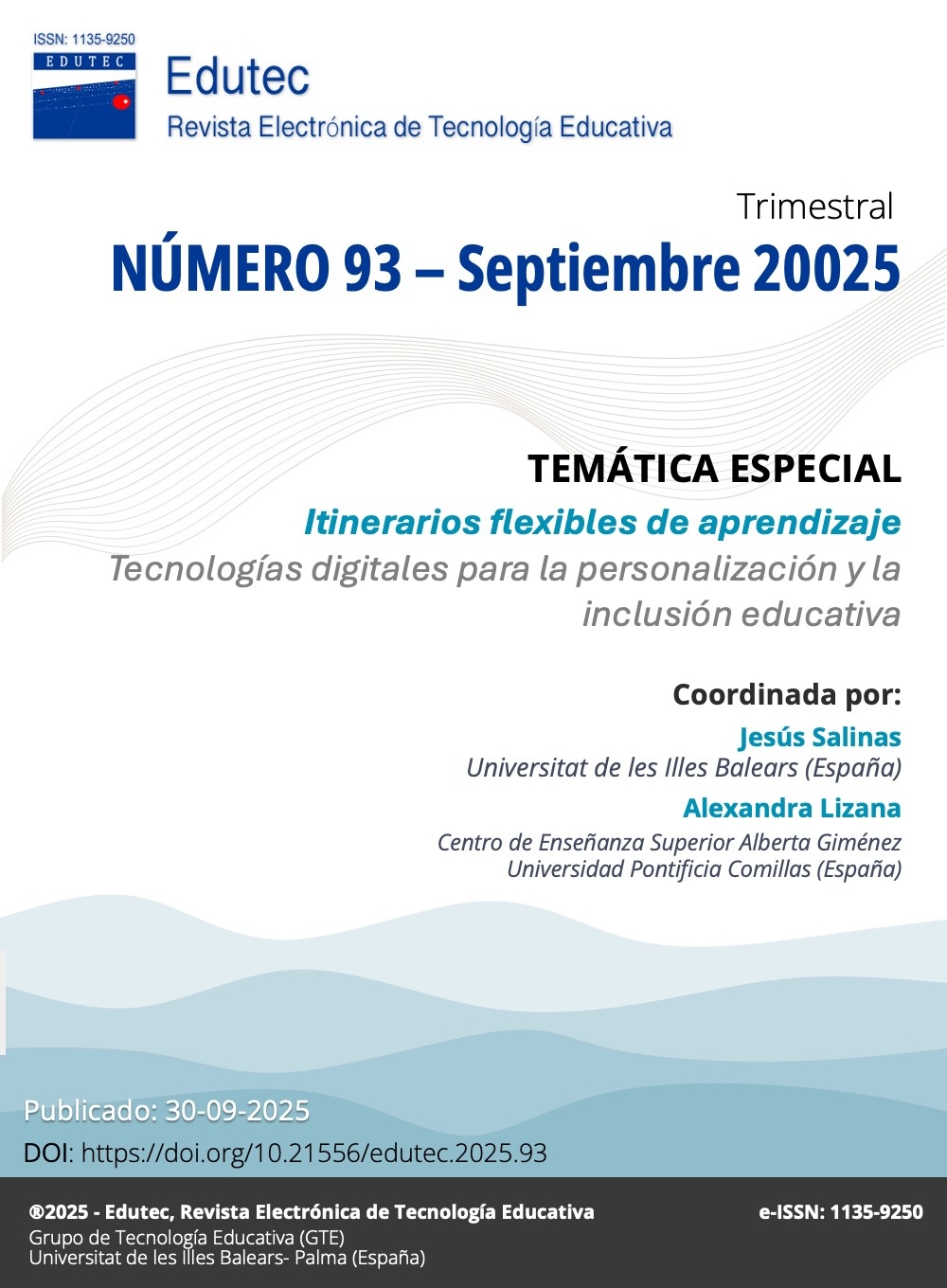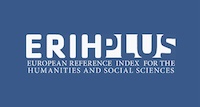Perception of the use of the interactive whiteboard in elementary school students in the peruvian context.
DOI:
https://doi.org/10.21556/edutec.2025.93.3597Keywords:
basic education, perception, Digital Interactive Board, information technologyAbstract
The use of digital tools has recently gained prominence in educational environments. The aim of the study was to validate and apply an instrument to evaluate the perception of the use of the interactive whiteboard (PDI) in the teaching-learning process, analyzing variables such as educational level and gender. Students from regular elementary school (6 to 12 years old) and high school (12 to 16 years old) in the Peruvian context participated in the study. The results of the validation of the instrument were processed with the KR -20 coefficient, obtaining a value of 0.765, which means that the instrument is ad hoc. Regarding the perception of the use of the PDI, in the learning dimension, a good level of acceptance was obtained, with a value of 90.6%; in the teaching and motivation dimensions, the level of acceptance was regular, with an acceptance value of 94.7% and 93.1%, respectively. Regarding the general perception of the PDI, a good level was obtained, with an acceptance value of 91.2%. Regarding the gender variable, the results indicate a greater acceptance by the male sex at both primary and secondary levels, highlighting a good level for the learning dimension.
Downloads
References
Alcívar, Y., Rodríguez, M., y Rivas, Y. (2023). El uso de las TIC en el proceso de enseñanza–aprendizaje. Cuadernos de Educación y Desarrollo, 13(1).https://ojs.europubpublications.com/ojs/index.php/ced/article/view/546
Al-Hariri, M., & Al-Hattami, A. (2017). Impact of students' use of technology on their learning achievements in physiology courses at the University of Dammam. Journal of Taibah University Medical Sciences, 12(1), 82-85. https://doi.org/10.1016/j.jtumed.2016.07.004 DOI: https://doi.org/10.1016/j.jtumed.2016.07.004
Alonso, C., Alconada, C., Gallego, D., y Dulac, J. (2015). La pizarra digital. Interactividad en el aula. ResearchGate. https://www.researchgate.net/publication/286863093_La_pizarra_digital_Interactiviadad_en_el_aula
Archundia, E., León, M., y Cerón, C. (2022). Experiencias tecnológicas en la educación (1ª ed.). BUAP Ediciones. https://www.cs.buap.mx/publicaciones/pub2022ExpTecEdu.php
Aflalo, E., Zana, L., & Huri, T. (2017). The interactive whiteboard in primary school science and interaction. Interactive Learning Environments, 26(4), 525–538. https://doi.org/10.1080/10494820.2017.1367695 DOI: https://doi.org/10.1080/10494820.2017.1367695
Arguello, M., y Vásquez, M. (2023). Efectividad de las pizarras digitales interactivas en el proceso de enseñanza-aprendizaje: Un meta-análisis de estudios empíricos. Revista Científica Kosmos, 2(2), 4-17. https://doi.org/10.62943/rck.v2n2.2023.45 DOI: https://doi.org/10.62943/rck.v2n2.2023.45
Bilý, J., & Miština, J. (2023). Using an Interactive Whiteboard to Increase the Effectiveness of Teaching at Secondary Schools. Research & Education - SOURCE, (s1), 38–49. https://doi.org/10.53349/resource.2023.is1.a1189 DOI: https://doi.org/10.53349/resource.2023.is1.a1189
Cabero Almenara, J. ., & valencia, rubicelia. (2020). And COVID-19 transformed the educational system: reflections and experiences to learn. IJERI: International Journal of Educational Research and Innovation, (15), 218–228. https://doi.org/10.46661/ijeri.5246 DOI: https://doi.org/10.46661/ijeri.5246
Cala, R., Díaz, L., Espí, N. y Tituaña, J. (2018). El Impacto del Uso de Pizarras Digitales Interactivas (PDI) en el Proceso de Enseñanza Aprendizaje. Un Caso de Estudio en la Universidad de Otavalo. Información tecnológica, 29(5), 61-70. https://dx.doi.org/10.4067/S0718-07642018000500061 DOI: https://doi.org/10.4067/S0718-07642018000500061
Calanchez, A., y Chávez, K. J. (2021). Apropiación social de la tecnología: una nueva necesidad como consecuencia de la Covid-19. Tecnología, Ciencia y Educación, (21), 183-198. https://doi.org/10.51302/tce.2022.720 DOI: https://doi.org/10.51302/tce.2022.720
Cascales, A., y Laguna, I. (2014). Una experiencia de aprendizaje con la pizarra digital interactiva en educación infantil. Pixel-Bit. Revista de Medios y Educación, (45), 125-136. https://www.redalyc.org/articulo.oa?id=36831300009
Castillo, J., Palta, N.; Sigüenza, P. (2016) Uso de pizarras digitales interactivas como recurso de enseñanza para los docentes. Revista de Experiencias/Innovación educativa, (28), 71-85. https://doi.org/10.1016/j.magis.2016.11.001 DOI: https://doi.org/10.1016/j.magis.2016.11.001
Díaz, J. P., Ruiz, A. K. y Egüez, C. (2021). Impacto de las TIC: Desafíos y oportunidades de la Educación Superior frente al Covid-19. Revista científica Uisrael, 8(1), 113-134. https://doi.org/10.35290/rcui.v8n2.2021.448 DOI: https://doi.org/10.35290/rcui.v8n2.2021.448
Expósito López, J., & Manzano García, B. (2010). tareas educativas interactivas, motivación y estrategias de aprendizaje, en educación primaria, a partir de un curriculum modulado por nuevas tecnologías. Teoría de la Educación. Educación y Cultura en la Sociedad de la Información, 11(1), 331-351. https://www.redalyc.org/comocitar.oa?id=201014897014 DOI: https://doi.org/10.14201/eks.6295
Guillén-Gámez, F., Romero, S., & Ordóñez, X. (2020). Diagnosis of the attitudes towards ICT of education students according to gender and educational modality. Apertura, 1(12), 56-71. https://www.redalyc.org/journal/688/68863614004/html/ DOI: https://doi.org/10.32870/Ap.v12n1.1786
Gonzáles, C. y Durán, J. (2015). La pizarra digital interactiva como recurso potenciador de la motivación. Revista de Comunicación Vivat Academia, (132), 1-19. https://www.redalyc.org/pdf/5257/525752884001.pdf DOI: https://doi.org/10.15178/va.2015.132.1-37
Hernández, R., Fernández, C., y Baptista, M. (2014). Metodología de la investigación (6ª ed.). McGraw Hill Education. https://apiperiodico.jalisco.gob.mx/api/sites/periodicooficial.jalisco.gob.mx/files/metodologia_de_la_investigacion_-_roberto_hernandez_sampieri.pdf
Instituto Nacional de Tecnologías Educativas y de Formación del Profesorado [INTEF] (2018, 8 de diciembre) La PDI en el aula. TIC en Educación Primaria. http://www.ite.educacion.es/formacion/materiales/183/cd/m8/la_pdi_en_el_aula.html
Instituto Nacional de Tecnologías Educativas y de Formación del Profesorado [INTEF] (2023, 27 de noviembre) La Comisión Europea impulsa la educación digital con dos recomendaciones claves. https://intef.es/Noticias/recomendaciones-ce/
Kennewell, S., & Beauchamp, G. (2007). The features of interactive whiteboards and their influence on learning. Learning, Media and Technology, 32(3), 227–241. https://doi.org/10.1080/17439880701511073 DOI: https://doi.org/10.1080/17439880701511073
Kühl, T., Wohninsland, P. Learning with the interactive whiteboard in the classroom: Its impact on vocabulary acquisition, motivation and the role of foreign language anxiety. Educ Inf Technol 27, 10387–10404 (2022). https://doi.org/10.1007/s10639-022-11004-9 DOI: https://doi.org/10.1007/s10639-022-11004-9
Kuric, S., Calderón-Gómez, D., y Sanmartín, A. (2021). Educación y brecha digital en tiempos del COVID-19. Perfiles y problemáticas experimentadas por el alumnado juvenil para afrontar sus estudios durante el confinamiento. Revista de Sociología de la Educación-RASE, 14(1), 63-84. http://dx.doi.org/10.7203/RASE.14.1.18265 DOI: https://doi.org/10.7203/RASE.14.1.18265
Macías, M., Zambrano, R., Intriago, J., Carpio, J., & Marcillo, M. (2017). Methodological strategy for the right use of the interactive whiteboard in the teaching-learning process of the english language in the university context (1ª ed.). Editorial Área de Innovación y Desarrollo S.L. https://3ciencias.com/wp-content/uploads/2017/09/Methodological-strategy-for-the-right-use-of-the-interactive-whiteboard.pdf DOI: https://doi.org/10.17993/DideInnEdu.2017.26
Morales, P. T., & García, J. M. S. (2015). Diseño y validación de cuestionarios para percibir el uso de la pizarra digital interactiva (PDI) por docentes y estudiantes. Pixel-Bit. Revista de Medios y Educación, (47), 179-194. https://www.redalyc.org/comocitar.oa?id=36841180012 DOI: https://doi.org/10.12795/pixelbit.2015.i47.12
Murado, J. (2011). Pizarra digital: Herramienta metodológica integral en el contexto del aula del siglo XXI (1ª ed.). Ideas propias.
Pérez, C. (2018). Actividades con la pizarra digital interactiva vs actividades con objetos reales en educación infantil [Trabajo de Fin de Grado en Educación Infantil]. Universidad Rey Juan Carlos. https://www.aprendecondedos.es/pdf/TFG-CristinaPerezSaez.pdf
Sánchez Chiquero D. (2013) La Pizarra Digital Interactiva en las aulas de Castilla-La Mancha: análisis del rendimiento y la integración. RED. Revista de Educación a Distancia, (38), 1-23. https://www.redalyc.org/articulo.oa?id=54728037003
Sánchez-Vera, M. (2023). Los desafíos de la Tecnología Educativa. RiiTE Revista Interuniversitaria de Investigación en Tecnología Educativa, (14), 1–5. https://doi.org/10.6018/riite.572131 DOI: https://doi.org/10.6018/riite.572131
San Martín, A., y Peirats, J. (2018). Controversias en la transición del libro de texto en papel y electrónico a los contenidos digitales. RED. Revista de Educación a Distancia, 18(56), 1-17. https://revistas.um.es/red/article/view/321501
Shi, Y., Peng, C., Yang, H. H., & MacLeod, J. (2018). Examining interactive whiteboard-based instruction on the academic self-efficacy, academic press and achievement of college students. Open Learning: The Journal of Open, Distance and e-Learning, 33(2), 115–130. https://doi.org/10.1080/02680513.2018.1454829 DOI: https://doi.org/10.1080/02680513.2018.1454829
Šumak, B., & Šorgo, A. (2016). The acceptance and use of interactive whiteboards among teachers: Differences in UTAUT determinants between pre- and post-adopters. Computers in Human Behavior, (64), 602-620. https://doi.org/10.1016/j.chb.2016.07.037 DOI: https://doi.org/10.1016/j.chb.2016.07.037
Tondeur, J., van Braak, J., Ertmer, P., & Ottenbreit-Leftwich, A. (2017). Understanding the relationship between teachers' pedagogical beliefs and technology use in education: A systematic review of qualitative evidence. Educational Technology Research and Development, 65(3), 555-575. https://doi.org/10.1007/s11423-016-9481-2 DOI: https://doi.org/10.1007/s11423-016-9481-2
Toledo Morales, P., & Sánchez García, J. M. (2015). Situación actual de las pizarras digitales interactivas en las aulas de primaria. Revista de Educación a Distancia (RED), (43). Recuperado a partir de https://revistas.um.es/red/article/view/236921
Organización de las Naciones Unidas para la Educación, la Ciencia y la Cultura [UNESCO] (2021, 24 de enero) La transformación digital durante la pandemia de la COVID-19 y los efectos sobre la docencia. https://www.iesalc.unesco.org/2021/01/24/la-transformacion-digital-durante-la-pandemia-de-la-covid-19-y-los-efectos-sobre-la-docencia/ DOI: https://doi.org/10.33588/fem.243.1129
Velastegui, E. (2019). Las pizarras digitales y su impacto didáctico en la educación superior. Revista explorador digital, 3(1), 49-63. https://doi.org/10.33262/exploradordigital.v3i1.346 DOI: https://doi.org/10.33262/exploradordigital.v3i1.346
Verde, M. (2014). El impacto de las TIC en la sociedad actual. La pizarra digital. [Tesis de Grado en Educación Primaria]. Universidad de Valladolid. https://uvadoc.uva.es/bitstream/10324/8103/1/TFGO%20312.pdf
Vico Linde, P. (2019). Percepción docente conforme al uso de los recursos digitales en la pizarra digital interactiva con alumnos de Necesidades Educativas Especiales. Edutec, Revista Electrónica De Tecnología Educativa, (69), 121–138. https://doi.org/10.21556/edutec.2019.69.1295 DOI: https://doi.org/10.21556/edutec.2019.69.1295
Published
How to Cite
Issue
Section
License
Copyright (c) 2025 Edutec, Revista Electrónica de Tecnología Educativa

This work is licensed under a Creative Commons Attribution 4.0 International License.
By submitting the paper, the authors assign the publication rights to the journal Edutec. For its part, Edutec authorises its distribution as long as its content is not altered and its origin is indicated. At the end of each article published in Edutec, the citation procedure is indicated.
The management and editorial board of Edutec Revista Electrónica de Tecnología Educativa do not accept any responsibility for the statements and ideas expressed by the authors in their work.
Translated with www.DeepL.com/Translator (free version)









